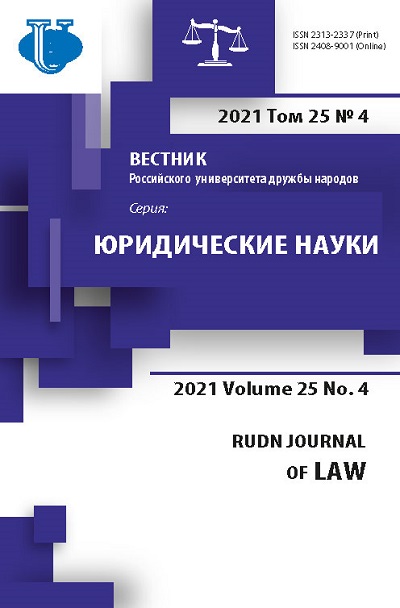Legal consequences for the state arising from the use of weapons against civil aircraft: review and legal framework development
- Authors: Novikova T.V.1, Kuts S.O.1
-
Affiliations:
- The North Caucasian branch of the Russian State University of Justice
- Issue: Vol 25, No 4 (2021)
- Pages: 831-854
- Section: INTERNATIONAL LAW. FOREIGN LAW
- URL: https://journals.rudn.ru/law/article/view/29513
- DOI: https://doi.org/10.22363/2313-2337-2021-25-4-831-854
- ID: 29513
Cite item
Full Text
Abstract
The authors elaborate on one of the controversial issues of international air law - safety of civil aircraft in flight in respect of the use of weapons against it. The first part of the present article considers major aerial accidents arising from shooting down the civil aircraft for the last 70 years as a factual basis for further legal analysis. In the second part, the authors back up customary prohibition of the use of weapons against civil aircraft in flight and legal consequences for states for violating the mentioned principle. The authors investigate the grounds for the ‘security exception’ and conclude that the only grounds for derogation from the principle of non-use of weapons against civil aircraft is Article 51 of the UN Charter proclaiming the inherent right of the state to self-defence. Even in this case, the application of the ‘security exception’ by the state is tolerated by using a set of precautions before employment of weapons. Finally, authors conclude that compensation for victims reflects the inevitable monetisation of human lives. Moreover, states’ negotiations reveal the controversial reality of trade-offs between them, where compensation amounts are occasionally affected by external political factors and current position of a particular state in the international community.
About the authors
Tatiana V. Novikova
The North Caucasian branch of the Russian State University of Justice
Author for correspondence.
Email: tnovikova@inbox.ru
ORCID iD: 0000-0002-8889-0444
Dean of the faculty of training specialists for the judicial system (Law faculty), Candidate of Legal Sciences, Associate Professor, International Law Department
234, Krasnykh Partizan str., Krasnodar, 350020, Russian FederationStepan O. Kuts
The North Caucasian branch of the Russian State University of Justice
Email: kutstefan@mail.ru
ORCID iD: 0000-0001-8008-7625
master (graduate) student, faculty of training specialists for the judicial system (Law faculty)
234, Krasnykh Partizan str., Krasnodar, 350020, Russian FederationReferences
- Beckham, J.A. (2015) Nation-State Culpability and Liability for Catastrophic Air Disasters: Reforming Public International Law to Allow for Liability of Nation-States and the Application of Punitive Damages. Florida International University Law Review. 10 (2), 585-633
- Cheng, C. (eds.) (2017) The Destruction of KAL Flight KE007, and Article 3 Bis of the Chicago Convention. In: Studies in International Air Law, Leiden, The Netherlands: Brill. https://doi.org/10.1163/9789004345140_015 [Accessed 10 July 2021]
- Crawford, J.R. (2006) The Creation of States in International Law. 2nd ed. Oxford University Press.
- Crawford, J.R. (2012) Brownlie’s Principles of Public International Law. 8th ed. Oxford University Press.
- Foont, B.E. (2007) Shooting down Civilian Aircraft: Is There an International Law. Journal of Air Law and Commerce. 72 (3), 695-725.
- Geiß, R. (2005) Civil Aircraft as Weapons of Large-Scale Destruction: Countermeasures, Article 3BIS of the Chicago Convention, and the Newly Adopted German “Luftsicherheitsgesetz”. Michigan Journal of International Law. 27 (1), 227-256
- Hughes, W.J. (1980) Aerial Intrusions by Civil Airliners and the Use of Force. Journal of Air Law and Commerce. 45 (3), 595-620.
- Leich, M.N. (1989) Denial of Liability: Ex Gratia Compensation on a Humanitarian Basis. American Journal of International Law. 83 (2), 319.
- Linnan, D.K. (1991) Iran Air Flight 655 and Beyond: Free Passage, Mistaken Self-defence, and State Responsibility. The Yale Journal of International Law. 16 (2), 245-389.
- McCarthy, G.M. (1984) Limitations on the Right to Use Force Against Civil Aerial Intruders: The Destruction of KAL Flight 007 in Community Perspective. New York Law School Journal of International and Comparative Law: 6 (1), 177-209
- Nase, V. et al. (2015) A Call for Legal Accountability in the Wake of the MH17 Tragedy. Journal of Air Law and Commerce. 80 (4), 639-692.
- Oron, Y. et al. (1960) Middle East Record Vol. I. London, Reuven Shiloah Research Center, Israel Oriental Society.
- Phelps, J.T. (1985) Aerial Intrusions by Civil and Military Aircraft in the Time of Peace. Military Law Review. (107), 256-303.
- Schwartz, J.B. (2007) Dealing with a “Rogue State”: The Libya Precedent. American Journal of International Law. (101), 553-570.
- Shaw, M.N. (2017) International Law. 8th ed. Cambridge University Press, p. 71.
- Whiteman, M. M. (ed.) (1967) Digest of international law Vol. VIII. Washington, D.C., U.S. Government Printing Office.
Supplementary files















